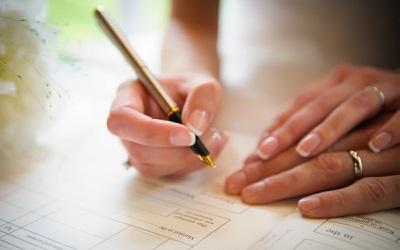You are here
- Home
- Business and Law in the time of Covid-19 archive
- The effect of the COVID-19 pandemic on weddings
The effect of the COVID-19 pandemic on weddings

This blog is written by Dr Stephanie Pywell and Professor Rebecca Probert. Stephanie is a Senior Lecturer in Law at The Open University, and a member of the Feminism, Gender and the Law research cluster; Rebecca is Professor of Law at the University of Exeter.
Like most other spheres of human activity, weddings were seriously affected by the COVID-19 pandemic. By early March, people in the UK were laughingly bumping elbows instead of shaking hands, and joking about what to sing to ensure that they washed their hands for 20 seconds. Over a period of roughly three weeks, the laughter turned to alarm as the situation changed at breath-taking speed: official guidance was issued, people started to adapt their behaviour to comply with it, then more restrictive guidance was rapidly issued. This is exemplified in the guidance issued by the Church of England (C of E) which, as the country’s established church, is the subject of the whole of Part II (sections 5–25) of the Marriage Act 1949.
In mid-March, it was announced that weddings should be ‘small’. Shortly after this, public worship was suspended. On 19 March, the C of E reported guidance that no more than five people – the priest, the bride and groom, and two witnesses – should attend a wedding ceremony, that everyone except the couple should observe social distancing, and that the priest should not touch the rings or the couple’s hands. Some couples hastily rearranged their weddings, only for all churches to be closed completely (except for essential maintenance), and weddings prohibited from going ahead – other than in exceptional circumstances – for an initially indeterminate period from the evening of Monday 23 March.
This ‘total lockdown’ applied immediately across the four nations of the United Kingdom, and lasted for many weeks, with ‘easing’ progressing at differing rates, and with inexplicable nuances, in the four nations.
Weddings in Northern Ireland were permitted from 8 June, provided that they took place outside and were attended by no more than 10 people. From 10 July they were allowed indoors, subject to restricted numbers determined by individual risk assessments. In Wales, weddings were allowed from 22 June, with no express restriction on the number of guests, but with two-metre social distancing being observed. Further guidance published on 7 July clarified that Welsh weddings could take place only subject to ‘the place of worship or Register Office being able to accommodate people safely, observing the physical distancing requirements’. Couples in Scotland were able to marry outdoors from 29 June, provided that the gathering comprised no more than eight people from a maximum of three households. Ceremonies could be held indoors from 15 July, subject to specified restrictions including their taking place ‘in a safe environment where the appropriate consideration has been given to reducing and avoiding the risk of transmission’ and being ‘concluded in the shortest reasonable time’. Weddings in England for up to 30 one-metre-plus socially distanced people, including the couple and any photographers, resumed on 4 July, but were not permitted to include singing, and couples were required to wash their hands before exchanging rings. The 30-person limit is somewhat arbitrary – a large cathedral could probably accommodate at least 200 people with appropriate social distancing, while a small room in a register office might be suitable for under 10 people – but it does have the benefit of being clear and measurable.
To explore the practical effects of these wedding-related restrictions on as wide a selection of couples in England and Wales as possible, we have launched an online survey, with recruitment via social media and snowball sampling, as well as our existing contacts. Couples will see one of four sets of questions, depending on how their plans changed, with the initial options being:
- We had been planning to marry between 24 March and 3 July 2020 (England)/21 June 2020 (Wales), but brought our wedding forward to an earlier date
- We had been planning to marry between 24 March and 3 July 2020 (England)/21 June 2020 (Wales), but were not able to do so during lockdown
- We had been planning to marry on or after 4 July 2020 (England)/22 June 2020 (Wales) and have changed our wedding plans
- We had not been planning to marry, but decided to do so because of the coronavirus.
As these choices indicate, we aim to include those who married earlier than they had planned, possibly because of grave illness, as well as those who have postponed weddings that could have gone ahead, albeit in a modified form.
Our findings will inform any recommendations that we may make for changes in the law of England and Wales; these may feed into the Law Commission’s forthcoming consultation for its Weddings project. We also plan to publish our findings in an academic paper.
If you, or anyone you know, has changed their wedding plans because of the pandemic,you can participate in the survey here.
If you saw an earlier version of this post, and sent an email to Wedding-Survey, we apologise that the email link broke over the weekend of 1–2 August. We hope that you’ll still wish to take part via the new direct link.
The writers of this blog, Dr Stephanie Pywell and Professor Rebecca Probert, have collaborated on previous research. Their empirical study on the content of civil marriage ceremonies, which was published in Child and Family Law Quarterly, has led to changes in practice in some registration districts, and they are currently working on an article about the inadequate provision of minimal civil wedding ceremonies. These two pieces, together with numerous articles that they have written individually, may eventually contribute to a long-overdue simplification of marriage law in England and Wales.